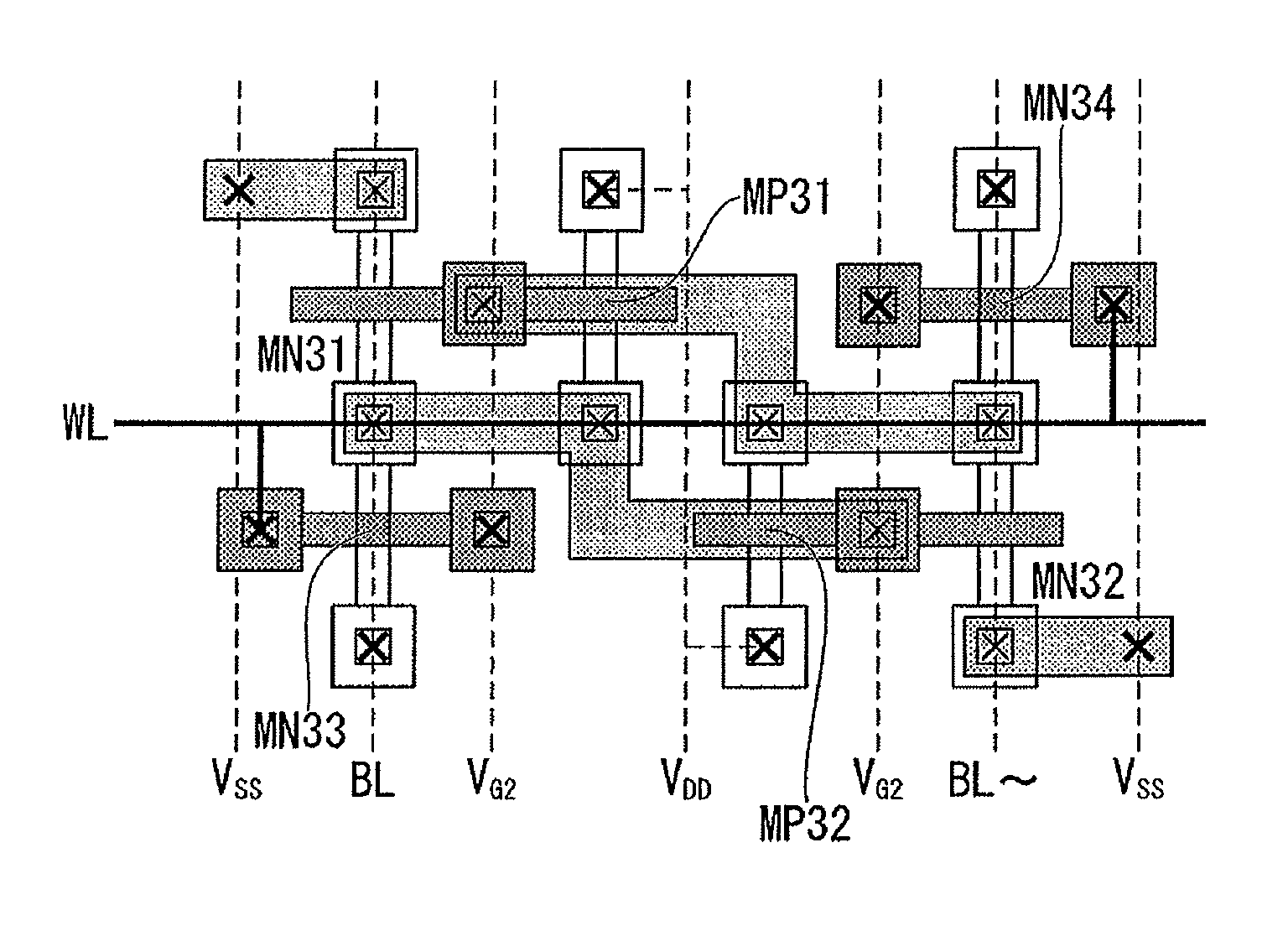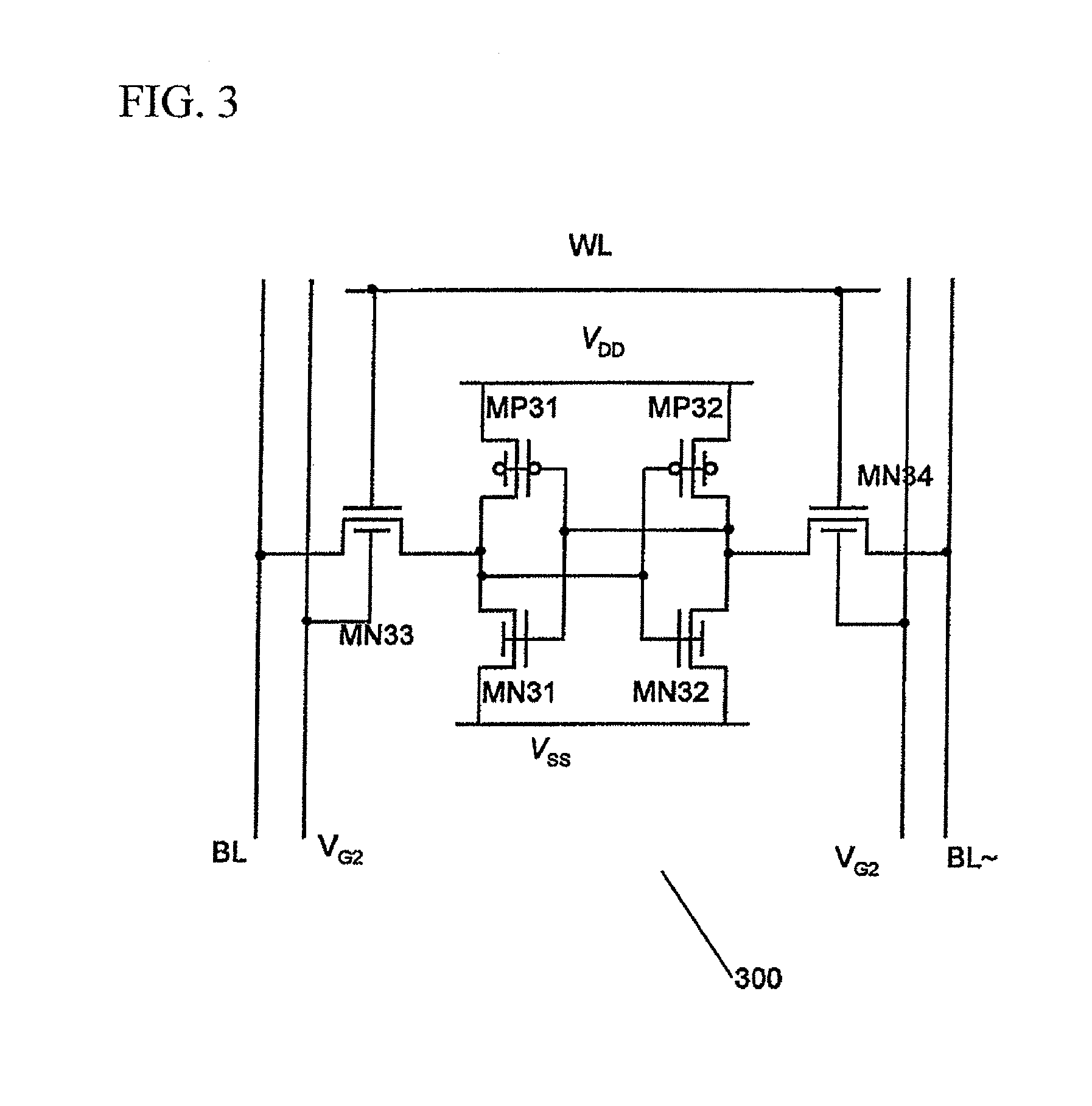SRAM device
a random access memory and sram technology, applied in semiconductor devices, digital storage, instruments, etc., can solve the problems of reducing the reliability of information systems, lowering the yield in the production process, and affecting the operation stability of sram, so as to increase the conductance of a selection transistor, and increase the read and write margins
- Summary
- Abstract
- Description
- Claims
- Application Information
AI Technical Summary
Benefits of technology
Problems solved by technology
Method used
Image
Examples
first embodiment
(First Embodiment)
[0059]As described above, the four-terminal double gate field effect transistor is used as the selection transistor. Each transistor constituting flip-flops is configured with a usual double gate field effect transistor of which two gates are connected. As a result, a 6-transistor SRAM cell is configured as shown in FIG. 3.
[0060]The terminals of the threshold voltage control gate of the four-terminal double gate field effect transistor, are connected to the wires parallel to bit lines BL and BL˜. Here, each MN31 and MN32 is different from the four-terminal double gate field effect transistor, and is a usual n-channel double gate field effect transistor of which two gates are connected to each other. MP31 and MP32 are the general p-channel double gate field effect transistors. In addition, the selection transistors MN33 and MN34 are the four-terminal double gate n-channel field effect transistors.
[0061]The SRAM cell shown in FIG. 3 is applied in the SRAM device show...
second embodiment
(Second Embodiment)
[0072]By selecting the capacitance of the gate insulating film and work function of the second gates 204 to 209 of the four-terminal double gate field effect transistor, the signal level, that is, the potential used in the VG2 and WL can be changed (refer to JP-A-2005-167163 and JP-A-2005-174960). Using this method appropriately, the invention can be applied even though either or both the VG2 and WL is changed in a range of VSS [=0]≦VG2≦VDD, VSS [=0]≦VWL≦VDD. Here, the configuration shown in FIG. 4 can be simplified as shown in FIG. 7. That is, the level shifter 401 is omitted from each row, and a CMOS inverter 701 shown in FIG. 8 is inserted instead of the level shifter 401 in each column, so that the same effect as that of the first embodiment can be attained. In FIG. 8, the MN71 is the n-channel field effect transistor, and the MP71 is the p-channel field effect transistor. Either the usual double gate field effect transistors or the conventional bulk planar MO...
third embodiment
(Third Embodiment)
[0074]In this embodiment, a layout when a memory cell 300 is implemented on a semiconductor substrate in practice is disclosed. FIG. 10 is a figure illustrating the layout of the SRAM cell which is implemented on the semiconductor substrate. By configuring the four-terminal double gate field effect transistor so as to be symmetrical about a point, the memory cell shown in FIG. 3 is implemented on the semiconductor substrate. Further, in FIG. 10, wires in second and third metal layers are respectively denoted by a solid line and a dotted line so as to be simply displayed. In addition, the symbol x shown in FIG. 10 indicates the positions of contacts or via holes.
PUM
 Login to View More
Login to View More Abstract
Description
Claims
Application Information
 Login to View More
Login to View More - R&D
- Intellectual Property
- Life Sciences
- Materials
- Tech Scout
- Unparalleled Data Quality
- Higher Quality Content
- 60% Fewer Hallucinations
Browse by: Latest US Patents, China's latest patents, Technical Efficacy Thesaurus, Application Domain, Technology Topic, Popular Technical Reports.
© 2025 PatSnap. All rights reserved.Legal|Privacy policy|Modern Slavery Act Transparency Statement|Sitemap|About US| Contact US: help@patsnap.com



